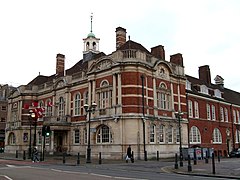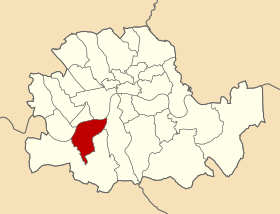| Battersea St Mary | |
|---|---|
 Former Battersea Town Hall (now Arts Centre) | |
 Metropolitan Borough of Battersea shown within the County of London | |
| Area | |
| • 1831 | 3,020 acres (12.2 km2)[1] |
| • 1851 | 2,343 acres (9.48 km2)[1] |
| • 1901 | 2,161 acres (8.75 km2)[1] |
| Population | |
| • 1801 | 3,365[1] |
| • 1851 | 10,560[1] |
| • 1901 | 168,907[1] |
| Density | |
| • 1851 | 4.5/acre |
| • 1901 | 78/acre |
| History | |
| • Origin | Ancient parish |
| • Abolished | 1965 |
| • Succeeded by | London Borough of Wandsworth |
| Status | Civil parish (until 1965) Metropolitan borough (1900—1965) |
| Government | Vestry of the Parish of Battersea (1888—1900) Battersea Borough Council (1900—1965) |
| • HQ | Municipal Buildings, Lavender Hill |
| • Motto | Non Mihi Non Tibi Sed Nobis (Not for me, not for thee, but for us) |
 Coat of arms of the borough council | |
 Map of borough boundary Map of borough boundary | |
Battersea was a civil parish and metropolitan borough in the County of London, England. In 1965, the borough was abolished and its area combined with parts of the Metropolitan Borough of Wandsworth to form the London Borough of Wandsworth. The borough was administered from Battersea Town Hall on Lavender Hill. That building is now Battersea Arts Centre.